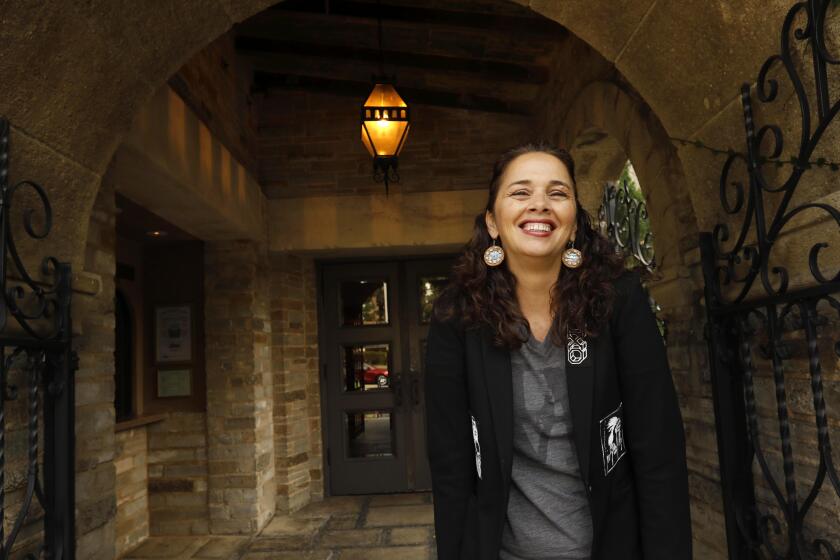James Franco takes an arty approach to his ‘General Hospital’ role
About four hours after soap opera and contemporary art fans arrived to watch actor James Franco tape an episode of “General Hospital” at the Pacific Design Center Thursday night, many were still baffled.
“Do you know what’s going on?” one asked in a not-so-quiet whisper. “I’m still learning myself,” answered another. Over the course of the evening, Franco found that he had a lot of explaining to do.
The event was “Soap at MOCA: James Franco on ‘General Hospital,’ ” hosted by the Los Angeles Museum of Contemporary Art. New MOCA director Jeffrey Deitch collaborated with Franco to produce what they consider a performance art project, which is elaborate and complex in its layers of fantasy and reality.
“Soap at MOCA” includes the taping of the episode; the event of watching the taping; the episode that will be broadcast on TV; and a film that Franco is making about the experience, which MOCA plans to screen at the museum.
To unravel these layers, it helps to start with the fictional story. Franco’s character on “General Hospital” — who is named “Franco” — is exhibiting his art in the plaza of the Pacific Design Center beneath the looming, bulky buildings known for their cobalt, emerald and crimson glass cladding.
The “art,” described by actor James Franco as “sculpture,” is a re-creation of four sets from his character’s world on “General Hospital.” The first is the character’s art studio, a messy, cluttered place stocked with spray paint cans and graffiti-style art covering the walls. A cream-colored room with colorful abstract paintings and “FRANCO” in silver lettering forms the second set. Another is the re-creation of a 1950s-style diner, complete with neon signage and a jukebox. The last is a glass box the size of a small room, the site where the character Franco had imprisoned a woman in a previous episode. (In addition to being an artist, “Franco” is a sociopath, actor Franco says.)
With this exhibit, “Franco” hopes to lure his adversary Jason from Port Charles, where “General Hospital” takes place, to MOCA in Los Angeles. Once at the Pacific Design Center, Jason falls into Franco’s “art trap,” James Franco says.
“Franco’s” art includes a performance by video and performance artist Kalup Linzy, who often dresses in drag. For the show, he wears a thick head of hair cascading down his back and a black dress with bright red sequined flowers.
At the climax of the episode, “Franco” jumps from a ledge of the iconic “Blue Whale” building into the diner-set below. Does he die or is it an illusion? Even the stunt man won’t tell. The episode won’t air until July 22, and Franco and the “General Hospital” crew are keeping most of the plot pretty hush-hush.
There were two audiences Thursday night: About 100 soap fans, or “junkies” as one guest called them, were confined in a barricaded area facing the sets. The relatively mellow crowd busied itself with taking photos while waiting for the shoot to begin. Meanwhile, MOCA-invited guests were free to roam the set and enjoy a cash bar at Spectra, the upscale lounge at the third floor of the Blue Whale. From there, the colorful set below was framed by a view of the Hollywood Hills skyline.
According to a museum spokesperson, the MOCA guest list included board members, trustees, artists, art dealers, collectors, Franco’s friends and Gus Van Sant, who directed Franco in the film “Milk.”
Franco and Deitch are intrigued by the idea of mixing low-brow entertainment forms with high class art.
“We’re not only bringing different disciplines together, we’re bringing different worlds together,” says Franco. “Here you have MOCA displaying an episode from ‘General Hospital,’ which is a soap opera. And within the soap opera, it’s an art show.” He says that by blurring the boundaries between art forms, he wants people to think about how they were created and understand their similarities.
For Deitch, “Soap at MOCA” is the beginning of a number of MOCA Pacific Design Center exhibits that will have a performance component, he says. In July MOCA will feature the work of film and video artist Ryan Trecartin. An exhibition by Iannis Xenakis, the radical architect and composer, is also planned. Deitch describes these events as “art cabaret.” He says he’s eager to “activate” the PDC branch and not neglect it as a “remote outpost.”
As the evening stretched toward 11 p.m., Franco, dressed in a tuxedo, had yet to film a complete scene. But his dark hair remained slicked back into place and his makeup hadn’t faded. As he laughed with mixed media artist Mark Bradford, his smile was as bright as it had been at 6 p.m.
At the other end of the plaza, Deitch, behind the circle-shaped lenses of his light green glasses, eagerly took in the scene. He talked with avant-garde fashion designer Jeremy Scott while gazing at the set-sculptures. “These are all the sets for the last episode,” he says with a bemused smile on his face. “And they’ll be gone by 6 a.m.”
More to Read
The biggest entertainment stories
Get our big stories about Hollywood, film, television, music, arts, culture and more right in your inbox as soon as they publish.
You may occasionally receive promotional content from the Los Angeles Times.





